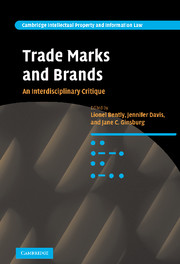Book contents
- Frontmatter
- Contents
- List of figures and tables
- Notes on the contributors
- Editors' preface
- Table of cases
- Table of statutes
- Part I Legal and economic history
- Part II Current positive law in the EU and the USA
- Part III Linguistics
- Part IV Marketing
- Part V Sociology
- 9 Trade mark style as a way of fixing things
- 10 The irrational lightness of trade marks: a legal perspective
- Part VI Law and Economics
- Part VII Philosophy
- Part VIII Anthropology
- Part IX Geography
- Bibliography
- Index
- Titles in the series
10 - The irrational lightness of trade marks: a legal perspective
Published online by Cambridge University Press: 13 April 2010
- Frontmatter
- Contents
- List of figures and tables
- Notes on the contributors
- Editors' preface
- Table of cases
- Table of statutes
- Part I Legal and economic history
- Part II Current positive law in the EU and the USA
- Part III Linguistics
- Part IV Marketing
- Part V Sociology
- 9 Trade mark style as a way of fixing things
- 10 The irrational lightness of trade marks: a legal perspective
- Part VI Law and Economics
- Part VII Philosophy
- Part VIII Anthropology
- Part IX Geography
- Bibliography
- Index
- Titles in the series
Summary
Professor Lury's thought-provoking chapter ‘Trade Mark Style as a Way of Fixing Things’ asserts that, in addition to their role as facilitators of transactions between manufacturers and consumers, trade marks have become a commercial asset in their own right. They have acquired an ability to exploit new forms of production and exchange, and a value as ‘an object or mode of capital accumulation’.
A rear-view mirror perspective
This commentary will complement her paper by offering a rear-view mirror perspective, in time and in the chain of commerce, to demonstrate how developments in UK trade mark laws have accommodated traders as they extend their personae through trade marks to organize production and exchange. In trade mark laws, trade marks are consistently attributed a source distinguishing function: to identify the traders responsible for putting the trade marked goods on the market, and to distinguish the traders' goods from those of other traders. Trade marks are defined by this source-distinguishing function. In the market, however, trade marks serve as identifiers of brands and play a role in organizing the consumer market thereby. In her chapter, ‘Trade Mark Style as a Way of Fixing Things’, Professor Lury has demonstrated that trade marks also play a role in organizing the producer market.
This chapter supports her observations by showing that the consumer protection rationale in trade mark laws is not consistently reflected in the legal mechanisms. These mechanisms, however, facilitate the extension of commercial identities which organize the producer market.
- Type
- Chapter
- Information
- Trade Marks and BrandsAn Interdisciplinary Critique, pp. 223 - 238Publisher: Cambridge University PressPrint publication year: 2008
- 1
- Cited by



